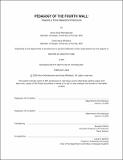| dc.contributor.advisor | Brandon Clifford. | en_US |
| dc.contributor.author | Marblestone, Kevin Allen. | en_US |
| dc.contributor.author | Whitbeck, Emily Mary. | en_US |
| dc.contributor.other | Massachusetts Institute of Technology. Department of Architecture. | en_US |
| dc.date.accessioned | 2021-02-19T20:20:02Z | |
| dc.date.available | 2021-02-19T20:20:02Z | |
| dc.date.copyright | 2020 | en_US |
| dc.date.issued | 2020 | en_US |
| dc.identifier.uri | https://hdl.handle.net/1721.1/129851 | |
| dc.description | Thesis: M. Arch., Massachusetts Institute of Technology, Department of Architecture, February, 2020 | en_US |
| dc.description | Cataloged from student-submitted thesis. | en_US |
| dc.description | Includes bibliographical references (page 97). | en_US |
| dc.description.abstract | Contemporary design pedagogy has failed to produce architects that can operate effectively within time-based global crises. In their attempts to address issues of sustainability and resiliency, architects have trapped themselves in a false binary, understanding structures to be either temporary or permanent. However, this considers only time-span. This shallow understanding of time has stifled the work produced by students and professionals today and reinforces the use of static mediums and conventions of orthography. Architecture needs a new generation of practitioners that can think differently about time. Rather than rely on private organizations that profit off of the desire for sustainability, we need to rely on the profession itself to produce new structures of thought. This thesis focuses on rethinking the true beginning of the design profession, the moment of inception, the first-year design studio. This course is structured as a pedagogical experiment that establishes a working methodology focused on time and perception, rather than program and form. In this course, time is considered the most malleable material at an architect's disposal. The curriculum engages a new critical eye on time, one that folds linear understandings of time in on themselves and acknowledges its cyclical, recursive nature. This new framework around time mandates the use of time-based media at the very beginning of the design process. The impact of propagating this pedagogy through an entire architectural education could produce a fleet of architects that are capable of addressing architecture through time. How could this then redirect the course of the profession? | en_US |
| dc.description.statementofresponsibility | by Kevin Allen Marblestone [and] Emily Mary Whitbeck. | en_US |
| dc.format.extent | 102 pages | en_US |
| dc.language.iso | eng | en_US |
| dc.publisher | Massachusetts Institute of Technology | en_US |
| dc.rights | MIT theses may be protected by copyright. Please reuse MIT thesis content according to the MIT Libraries Permissions Policy, which is available through the URL provided. | en_US |
| dc.rights.uri | http://dspace.mit.edu/handle/1721.1/7582 | en_US |
| dc.subject | Architecture. | en_US |
| dc.title | Pedagogy of the fourth wall : toward a time-based architecture | en_US |
| dc.title.alternative | Toward a time-based architecture | en_US |
| dc.type | Thesis | en_US |
| dc.description.degree | M. Arch. | en_US |
| dc.contributor.department | Massachusetts Institute of Technology. Department of Architecture | en_US |
| dc.identifier.oclc | 1236894169 | en_US |
| dc.description.collection | M.Arch. Massachusetts Institute of Technology, Department of Architecture | en_US |
| dspace.imported | 2021-02-19T20:19:02Z | en_US |
| mit.thesis.degree | Master | en_US |
| mit.thesis.department | Arch | en_US |
